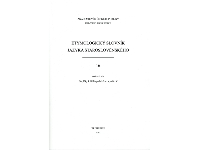Etymologický slovník jazyka staroslověnského

Team of authors of the Department of Etymology
Editors-in-chief: Eva Havlová (volumes 1–6), Adolf Erhart (volumes 6–12), Ilona Janyšková (volume 13–21)
Praha, Academia (volume 1–14); Brno, Tribun EU (volme 15–21)
Vol. 21: Indexes of non-Slavic languages. 2022. 82 pp.
Vol. 20: Indexes of Slavic languages. 2021. 252.
Vol. 19: zakonъ – žьzlъ. Bibliografy. 2018; pp. 1123–1164 + I–LXXX.
Vol. 18: větъ – zakonъ. 2016; pp. 1059–1122.
Vol. 17: trь- – větъ. 2014; pp. 995–1058.
Vol. 16: sьde – trъtъ. Supplements to bibliography V. 2012; pp. 935–994 + XXVI–XXIX.
Vol. 15: srъdьce – sь. 2010; pp. 871–934.
Vol. 14: sice – srъdobolja. Supplements to bibliography IV. 2008; pp. 815–870 + XVIII–XXV.
Vol. 13: rasti – sice. 2006; pp. 751–814.
Vol. 12: pǫpъ1 – rasti. Supplements to bibliography III. 2004; pp. 695–751 + XI–XVII.
Vol. 11: patrachъ – -pǫditi. 2002; pp. 631–694.
Vol. 10: obrěsti – patěna. 2000; pp. 567–630.
Vol. 9: mrъkati – obrěsti. 1999; pp. 503–566.
Vol. 8: luna – mrъcati. Supplements to bibliography II. 1998; pp. 445–502 + V–X.
Vol. 7: kuditi – luna. 1997; pp. 381–444.
Vol. 6: klęti – kuditi. 1996; pp. 317–380.
Vol. 5: istopiti sę – klęti. 1995; pp. 253–316.
Vol. 4: gostь – istonǫti. Supplements to bibliography I. 1994; pp. 193–252 + I–IV.
Vol. 3: dělo – gospodь. 1992; pp. 129–192.
Vol. 2: blagъ – dělo. 1990; pp. 65–128.
Vol. 1: Úvod, zkratky. A – blagъ. 1989; pp. 1–64.
The dictionary gives an explanation of the origin of all Old Slavonic words. It places the Old Slavonic lexis in the context of Slavic languages and shows the ways of expanding it by adopting words from cultural languages, especially Greek. The dictionary lists and explains the material and cultural realia of the ancient Slavs. The entries are arranged alphabetically. They contain the grammatical characteristics and derivatives of the headword and indicate its word-formation and semantic development. The etymological part of the entries provides equivalents from other Slavic languages and its own etymological interpretation. Cyrillic and Glagolitic alphabets are transcribed into Latin.